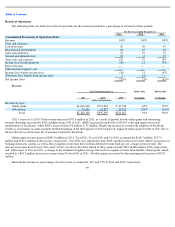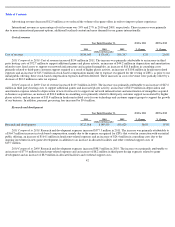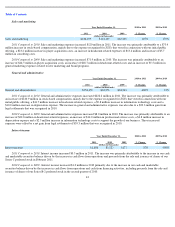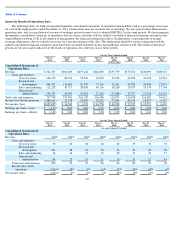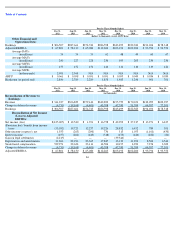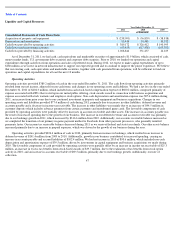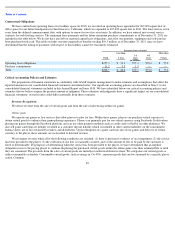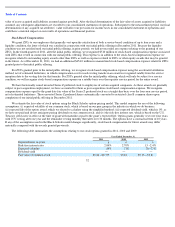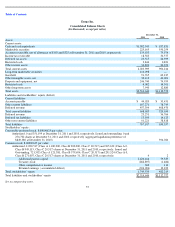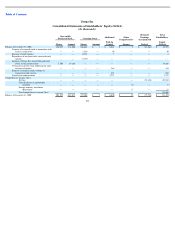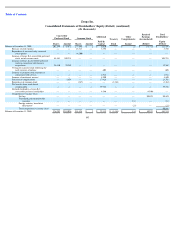Zynga 2011 Annual Report Download - page 54
Download and view the complete annual report
Please find page 54 of the 2011 Zynga annual report below. You can navigate through the pages in the report by either clicking on the pages listed below, or by using the keyword search tool below to find specific information within the annual report.
Table of Contents
characteristics of consumable goods may include virtual goods that are no longer displayed on the player’s game board after a short period of
time, do not provide the player any continuing benefit following consumption or often times enable a player to perform an in-game action
immediately. For the sale of consumable virtual goods, we recognize revenue as the goods are consumed. Durable virtual goods, such as tractors
in FarmVille , represent virtual goods that are accessible to the player over an extended period of time. We recognize revenue from the sale of
durable virtual goods ratably over the estimated average playing period of paying players for the applicable game, which represents our best
estimate of the average life of our durable virtual goods. If we do not have the ability to differentiate revenue attributable to durable virtual goods
from consumable virtual goods for a specific game, we recognize revenue from the sale of durable and consumable virtual goods for that game
ratably over the estimated average period that paying players typically play our games (as further discussed below), which ranged from eight to
25 months in 2011. Future paying player usage patterns and behavior may differ from the historical usage patterns and therefore the estimated
average playing periods may change in the future.
Prior to October 1, 2009, we did not have the data to determine the consumption dates for our consumable virtual goods or to differentiate
revenue attributable to durable virtual goods from consumable virtual goods. Beginning in October 2009, we had sufficient data to separately
account for consumable and durable virtual goods in one of our games, thus allowing us to recognize revenue related to consumable goods upon
consumption. Since January 2010, we have had this data for substantially all of our games, thus allowing us to recognize revenue related to
consumable goods upon consumption. We expect that in future periods there will be changes in the mix of durable and consumable virtual goods
sold, reduced virtual good sales in existing games, changes in estimates in average paying payer life and/or changes in our ability to make such
estimates. When such changes occur, and in particular if more of our revenue in any period is derived from goods for which revenue is
recognized over the estimated average playing period, or that period increases on average, the amount of revenue that we recognize in a future
period may be reduced, perhaps significantly.
On a quarterly basis, we determine the estimated average playing period for paying players by game beginning at the time of a payer’
s first
purchase in that game and ending on a date when that paying player is no longer playing the game. To determine when paying players are no
longer playing a given game, we analyze monthly cohorts of paying players for that game who made their first in-
game payment between six and
18 months prior to the beginning of each quarter and determine whether each player within the cohort is an active or inactive player as of the
date of our analysis. To determine which players are inactive, we analyze the dates that each paying player last logged into that game. We
determine a paying player to be inactive once they have reached a period of inactivity for which it is probable (defined as at least 80%) that a
player will not return to a specific game. For the payers deemed inactive as of our analysis date we analyze the dates they last logged into that
game to determine the rate at which inactive players stopped playing. Based on these dates we then project a date at which all paying players for
each monthly cohort are expected to cease playing our games. We then average the time periods from first purchase date and the date the last
player is expected to cease playing the game for each of the monthly cohorts to determine the total playing period for that game. To determine
the estimated average playing period we then divide this total playing period by two. The use of this “average” approach is supported by our
observations that paying players become inactive at a relatively consistent rate for each of our games. If future data indicates paying players do
not become inactive at a relatively consistent rate, we will modify our calculations accordingly. If a new game is launched and only a limited
period of paying player data is available for our analysis, then we also consider other factors, such as the estimated average playing period for
other recently launched games with similar characteristics, to determine the estimated average playing period.
In May 2010, we entered into an agreement with Facebook to accept Facebook Credits as the primary in-game payment method for our
games played through the Facebook platform. The agreement required us to begin migrating our games to Facebook Credits in our games
beginning in July 2010, and by April 2011 this migration was complete. Facebook Credits is Facebook’s proprietary virtual currency that
Facebook sells for use on the Facebook platform. Under the terms of our agreement, Facebook sets the price our players pay for Facebook
Credits and collects the cash from the sale of Facebook Credits. Facebook’s current stated face value
50


